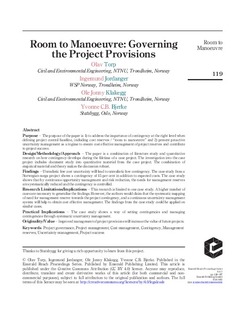| dc.contributor.author | Torp, Olav | |
| dc.contributor.author | Ingemund, Jordanger | |
| dc.contributor.author | Klakegg, Ole Jonny | |
| dc.contributor.author | Bjerke, Yvonne C. | |
| dc.date.accessioned | 2019-10-25T07:16:45Z | |
| dc.date.available | 2019-10-25T07:16:45Z | |
| dc.date.created | 2019-10-24T13:27:12Z | |
| dc.date.issued | 2019 | |
| dc.identifier.isbn | 978-1-83867-051-1 | |
| dc.identifier.uri | http://hdl.handle.net/11250/2624322 | |
| dc.description.abstract | Purpose – The purpose of the paper is 1) to address the importance of contingency at the right level when defining project control baseline, including cost reserves / “room to manoeuvre” and 2) present proactive uncertainty management as a regime to ensure cost effective management of project reserves and contribute to project success. Design/Methodology/Approach – The paper is a combination of literature study and quantitative research on how contingency develops during the lifetime of a case project. The investigation into the case project includes document study into quantitative material from the case project. The combination of empirical material and theory makes the discussion robust. Findings – Unrealistic low cost uncertainty will lead to unrealistic low contingency. The case study from a Norwegian mega project shows a contingency of 15 per cent in addition to expected costs. The case study shows that by continuous opportunity management and risk reduction, the needs for management reserves are systematically reduced and the contingency is controlled. Research Limitations/Implications – This research is limited to one case study. A higher number of cases are necessary to generalise the findings. However, the authors would claim that the systematic mapping of need for management reserve towards the project contingency, and a continuous uncertainty management system will help to obtain cost effective management. The findings from the case study could be applied on similar cases. Practical Implications – The case study shows a way of setting contingencies and managing contingencies through systematic uncertainty management. Originality/Value – Improved management of project provisions will increase the value of future projects. | nb_NO |
| dc.language.iso | eng | nb_NO |
| dc.publisher | Emerald | nb_NO |
| dc.relation.ispartof | Volume 2 - 10th Nordic Conference on Construction Economics and Organization | |
| dc.relation.uri | https://www.emerald.com/insight/content/doi/10.1108/S2516-285320190000002058/full/pdf?title=room-to-manoeuvre-governing-the-project-provisions | |
| dc.rights | Navngivelse 4.0 Internasjonal | * |
| dc.rights.uri | http://creativecommons.org/licenses/by/4.0/deed.no | * |
| dc.title | Room to Manoeuvre: Governing the Project Provisions | nb_NO |
| dc.type | Chapter | nb_NO |
| dc.description.version | publishedVersion | nb_NO |
| dc.source.pagenumber | 119-127 | nb_NO |
| dc.identifier.doi | 10.1108/S2516-285320190000002058 | |
| dc.identifier.cristin | 1740234 | |
| dc.description.localcode | Copyright © 2019, Olav Torp, Ingemund Jordanger, Ole Jonny Klakegg, Yvonne C.B. Bjerke. License Published in the Emerald Reach Proceedings Series. Published by Emerald Publishing Limited. This article is published under the Creative Commons Attribution (CC BY 4.0) licence. | nb_NO |
| cristin.unitcode | 194,64,91,0 | |
| cristin.unitname | Institutt for bygg- og miljøteknikk | |
| cristin.ispublished | true | |
| cristin.fulltext | original | |
| cristin.qualitycode | 1 | |

